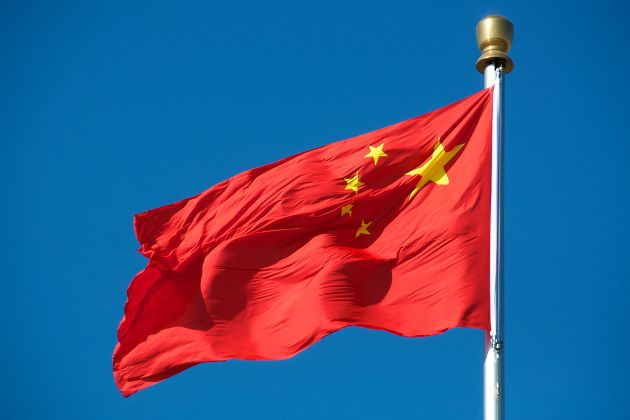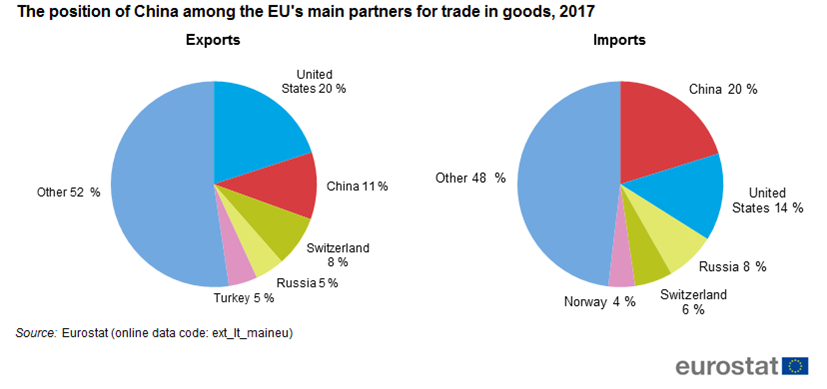-
 Podcast - How much is Greece getting out of the RRF?
Podcast - How much is Greece getting out of the RRF?
-
 Podcast - Between investment grade and rule of law: Greece's contrasting images
Podcast - Between investment grade and rule of law: Greece's contrasting images
-
 Where is Greek growth coming from?
Where is Greek growth coming from?
-
 Bravo, Bank of Greece
Bravo, Bank of Greece
-
 Podcast - A year on from Tempe train crash, trust fades as questions mount
Podcast - A year on from Tempe train crash, trust fades as questions mount
-
 Podcast - SYRIZA embraces the chaos
Podcast - SYRIZA embraces the chaos
Summit to usher in a new stage of EU-China relations

The upcoming EU-China summit in Brussels on 9 April will have a lavish menu, for sure. China is the EU’s second biggest trade partner after the US, while the EU is China’s biggest.
The EU and China have joined hands on a number of issues of global relevance, such as the Paris Agreement on combating climate change and the implementation of the Joint Comprehensive Plan of Action (JCPOA) on Iran, despite the pull-out of the US from both deals.
Venezuela, the Korean peninsula and Afghanistan will also be included in the agenda of the summit.

Yet, the talks are likely to be marred by an unprecedented level of confrontation between the two delegations, less than two weeks after the visit of Chinese president Xi Jinping to Italy and France. Rome’s flirtation with Beijing’s landmark Belt and Road Initiative (BRI) has caused a great deal of consternation in Brussels and other European capitals. There has been a salvo of critical remarks that the Italian government signed a Memorandum of Understanding with Beijing, without weighing the geopolitical risks and growing concerns about China’s burgeoning global aspirations. Western partners, including a furious US, claim that they were not duly consulted with and it is felt that Beijing is driving a wedge into the EU and the euroatlantic alliance.
The French president Emmanuel Macron did not miss the opportunity to sign multi-billion agreements with his Chinese counterpart. Yet, he also made a strong point by inviting the German chancellor Angela Merkel and the European Commission's president Jean-Claude Juncker to a joint meeting with Xi, thus sending across a clear message about a united European approach to Chinese advances in Europe. He even spoke about a much-needed “awakening” and the end of “European naïveté” towards China.
Tension building
These statements by no means came out of the blue - the tension between the EU and China has been palpable for some time now. There has been growing frustration in the EU after years of engagement with Beijing on the EU-China Comprehensive Αgreement for Ιnvestment (CAI), which has gone through no fewer than 19 rounds of negotiation since November 2013. Europeans are increasingly annoyed by the fact that China has been dragging its feet in opening up its economy, but also by what they see as Beijing’s incremental slide into European territory. Heated debates on Huawei and the security of 5G networks to be built in Europe have only aggravated suspicion and concerns about China.
The writing has been on the wall for at least a year and a half now. In his 2017 State of the Union address, Jean-Claude Juncker referred to European harbours, energy infrastructure or defence technology firms that have been taken over by Chinese corporations and spoke about “a political responsibility to know what is going on in our own backyard, so that we can protect our collective security if needed.” During his visit to China in January 2018, Macron stated in no ambiguous terms that China’s new Silk Road is not one-way, hammering home the persistent European demand for reciprocity in the relations between the EU and China. Soon after that, 27 European ambassadors based in Beijing, signed a report critical of BRI, arguing that the initiative almost exclusively promotes Chinese interests.
Last March, the Council gave the green light to an EU-wide FDI screening mechanism, which is largely seen as a preventive measure against Chinese takeovers of critical infrastructure in Europe. A few days later, the European Commission and the High Representative issued a Joint Communication, titled EU-China Strategic Outlook, which stressed that neither the EU nor any of its member states can effectively achieve their aims with China without full unity. Moreover, this is the first time ever China is dubbed “simultaneously a cooperation partner [...], an economic competitor in pursuit of technological leadership, and a systemic rival promoting alternative models of governance.” This paper comes on the heels of two important policy documents on both sides: (i) The September 2018 resolution of the European Parliament on EU-China relations, which brought up a number of “unpalatable” issues between the two sides; (ii) the December 2018 China’s Policy Paper on the EU, which was marked by Beijing’s unprecedented assertiveness.
Summit expectations
On the face of it, the timing of the EU-China is not auspicious, mostly because of several pending issues, all of which distract Europeans’ attention. The never-ending Brexit saga is the single biggest concern of the EU at the moment. Furthermore, member states are on the campaign trail towards a new European Parliament, which is likely to be heavily fragmented and unwieldy. Brussels is anxiously awaiting the outcome of the US-China negotiations launched last September after the Trump-Xi tête-à-tête in Buenos Aires – there’s no doubt that this will have a huge impact on the complicated relations within the US-China-EU triangle.
But worse than the timing of the summit is a long list of structural challenges Europe is up against. The EU is in its worst shape since the oil shocks of the 1970s, there’s no hiding it. It is on the backfoot vis-à-vis the US and China. Its internal cohesion has been dented by dissent, so amply displayed by the shouting matches over a narrowly-avoided Grexit several years ago, the current Brexit spectre, an acute migrant crisis, a surge of euroscepticism across the continent and, not least of all, a wide array of oft-conflicting views on how Europe should go about China. So, is the EU ready for this summit?
Interestingly, despite low expectations, the summit may actually turn out to be a watershed. While the EU is unlikely to pull a rabbit out of a hat and work miracles in its tense relationship with China, this event may help it reinforce its international standing for at least two reasons:
- Despite all the above challenges - or because of them -, EU officials appear to be determined, more than ever, for a hard talk with Beijing, without mincing their words. The EU’s language has never been so straightforward. Never in the past has the EU come up with such a realistic assessment of China and such a robust approach. This is more than just a change of tack – it’s a change of strategy. Never in the past has the EU set deadlines to Beijing, which is now called on to accelerate the CAI negotiations and commit to their conclusion by 2020. On WTO reform, the EU doesn’t shy away from spelling out major “irritants”, such as subsidies and forced technology transfers – two key issues the US also prioritises in its bras-de-fer with Beijing. Europeans also urge China to “cap its CO2 emissions before 2030” in accordance with its commitment to the Paris Agreement on combating climate change.
- Could newly found European assertiveness lead to a fall-out between the EU and China? Highly unlikely. Global Times and other beacons of Beijing’s increasingly crude and unconvincing propaganda machinery will surely make their usual noises, but China doesn’t have the luxury of a headlong clash with Europe. Faced with crucially important negotiations with Washington and its own economic slowdown at home, Beijing will duly record European demands, while crooning its hackneyed song about “shared destiny” and “win-win cooperation”.
The tone of EU-China talks matters a lot and this is what the cohorts of reporters will be on the lookout for on 9 April. But the real outcome of the meeting will probably become clearer in the months to come. Three key indicators to watch will be:
- The degree of Beijing’s responsiveness to the 10 measures spelled out in the EU-China Stategic Outlook. Under the recently adopted new investment law in China, Beijing pledges a shorter negative list of industries, i.e. sectors which are off-limits for FDI at present, and may somewhat curb the practice of forced technology transfers.
- Related to that, progress on CAI negotiations will be extremely important, in the wake of the deal that Beijing seeks to strike with Washington. Most probably, there will be a deal in the end, as China cannot afford a full-blown trade war with the US. The question for Europeans will be to what extent they can make the most of concessions made by Beijing to Washington, with a view to another set of strenuous negotiations on WTO reform.
- Achieving some semblance of EU-wide coordination and limiting the number of member states breaking ranks with Brussels in favour of bilateral arrangements with Beijing. Despite the adoption of the FDI screening mechanism, member states are unlikely to stop vying for Chinese investment, be it in transport and energy infrastructure or the telecoms sector, as the dispute over 5G and Huawei shows. Lastly, the million-dollar question at the upcoming 16+1 summit in Croatia will be whether this controversial initiative could turn into 17+1, all eyes being on the usual suspect Greece.
Therefore, whether or not the EU can have its ducks in a row and will manage to stand its ground vis-à-vis Beijing remains to be seen. But it is quite clear that the EU needs to recalibrate its ties with China, in order to address growing threats to trade, investment and security posed by Beijing’s global assertiveness. And, as the Chinese foreign minister Wang Yi acknowledged recently, competition between China and the EU “may be inevitable”, despite their strategic partnership in certain areas. Which is what the 9 April summit will most certainly confirm.
*Plamen Tonchev is the Head of Asia Unit at the Institute of International Economic Relations in Athens.